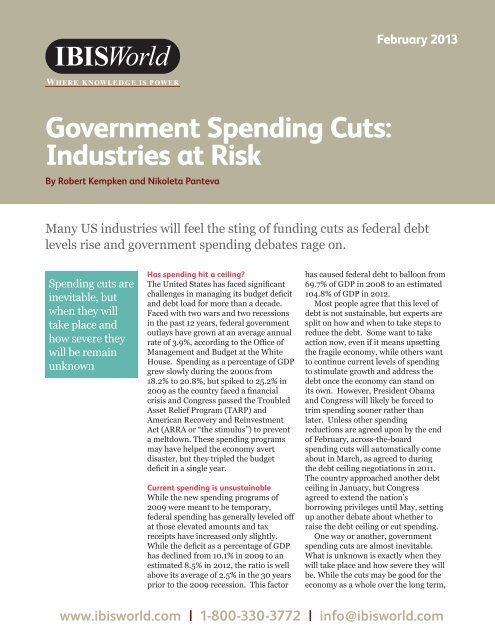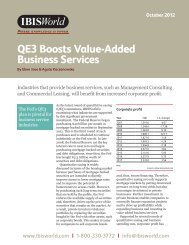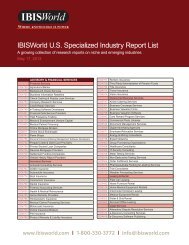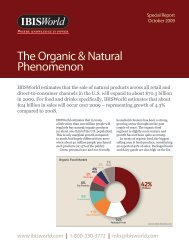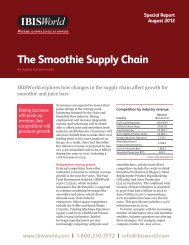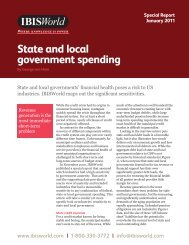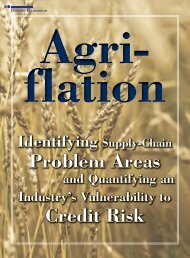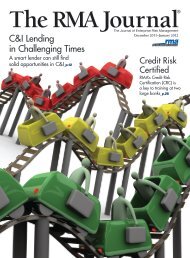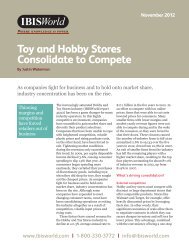here - IBISWorld
here - IBISWorld
here - IBISWorld
Create successful ePaper yourself
Turn your PDF publications into a flip-book with our unique Google optimized e-Paper software.
WWW.IBISWORLD.COM February 2013 1<br />
Government Spending Cuts: Industries at Risk<br />
February 2013<br />
Government Spending Cuts:<br />
Industries at Risk<br />
By Robert Kempken and Nikoleta Panteva<br />
Many US industries will feel the sting of funding cuts as federal debt<br />
levels rise and government spending debates rage on.<br />
Spending cuts are<br />
inevitable, but<br />
when they will<br />
take place and<br />
how severe they<br />
will be remain<br />
unknown<br />
Has spending hit a ceiling?<br />
The United States has faced significant<br />
challenges in managing its budget deficit<br />
and debt load for more than a decade.<br />
Faced with two wars and two recessions<br />
in the past 12 years, federal government<br />
outlays have grown at an average annual<br />
rate of 3.9%, according to the Office of<br />
Management and Budget at the White<br />
House. Spending as a percentage of GDP<br />
grew slowly during the 2000s from<br />
18.2% to 20.8%, but spiked to 25.2% in<br />
2009 as the country faced a financial<br />
crisis and Congress passed the Troubled<br />
Asset Relief Program (TARP) and<br />
American Recovery and Reinvestment<br />
Act (ARRA or “the stimulus”) to prevent<br />
a meltdown. These spending programs<br />
may have helped the economy avert<br />
disaster, but they tripled the budget<br />
deficit in a single year.<br />
Current spending is unsustainable<br />
While the new spending programs of<br />
2009 were meant to be temporary,<br />
federal spending has generally leveled off<br />
at those elevated amounts and tax<br />
receipts have increased only slightly.<br />
While the deficit as a percentage of GDP<br />
has declined from 10.1% in 2009 to an<br />
estimated 8.5% in 2012, the ratio is well<br />
above its average of 2.5% in the 30 years<br />
prior to the 2009 recession. This factor<br />
has caused federal debt to balloon from<br />
69.7% of GDP in 2008 to an estimated<br />
104.8% of GDP in 2012.<br />
Most people agree that this level of<br />
debt is not sustainable, but experts are<br />
split on how and when to take steps to<br />
reduce the debt. Some want to take<br />
action now, even if it means upsetting<br />
the fragile economy, while others want<br />
to continue current levels of spending<br />
to stimulate growth and address the<br />
debt once the economy can stand on<br />
its own. However, President Obama<br />
and Congress will likely be forced to<br />
trim spending sooner rather than<br />
later. Unless other spending<br />
reductions are agreed upon by the end<br />
of February, across-the-board<br />
spending cuts will automatically come<br />
about in March, as agreed to during<br />
the debt ceiling negotiations in 2011.<br />
The country approached another debt<br />
ceiling in January, but Congress<br />
agreed to extend the nation’s<br />
borrowing privileges until May, setting<br />
up another debate about whether to<br />
raise the debt ceiling or cut spending.<br />
One way or another, government<br />
spending cuts are almost inevitable.<br />
What is unknown is exactly when they<br />
will take place and how severe they will<br />
be. While the cuts may be good for the<br />
economy as a whole over the long term,<br />
www.ibisworld.com | 1-800-330-3772 | info@ibisworld.com
WWW.IBISWORLD.COM February 2013 2<br />
Government Spending Cuts: Industries at Risk<br />
in the short term, they will negatively<br />
impact many US industries that rely on<br />
the federal government as a major<br />
customer or as a financial supporter.<br />
<strong>IBISWorld</strong> examines the effects that a<br />
reduction in spending programs will<br />
have on the industries most reliant on<br />
the federal government.<br />
Impact of spending cuts on industries<br />
<strong>IBISWorld</strong> identified 94 industries that<br />
would be directly impacted if federal<br />
government spending is cut back.<br />
Together, these industries generate an<br />
excess of $5.9 trillion in revenue and<br />
employ more than 36 million people.<br />
<strong>IBISWorld</strong> profiles five of these<br />
industries based on their size and the<br />
importance of government spending on<br />
their operations.<br />
Public Schools (<strong>IBISWorld</strong> report<br />
61111a) are expected to generate $685.3<br />
billion in revenue in 2013 and employ<br />
6.5 million individuals. In 2009,<br />
Congress passed the American Recovery<br />
and Reinvestment Act (ARRA) in<br />
response to the recession. The ARRA<br />
allocated $100.0 billion to education,<br />
which went toward teacher salaries,<br />
school repairs, Pell Grants and lowincome<br />
public school children, among<br />
other areas. Any spending cuts in<br />
education would severely reduce this<br />
industry’s revenue. Cutbacks could<br />
result in layoffs, loss of school<br />
transportation and even school closures.<br />
The Public Schools industry is highly<br />
reliant on federal government funds<br />
and is at high risk for cuts when<br />
spending comes into question.<br />
The $156.3 billion Aircraft, Engine<br />
and Parts Manufacturing industry<br />
(33641a) generates about 20.0% of its<br />
revenue through government military<br />
contracts. While defense spending<br />
jumped during the past five years due to<br />
the wars in the Middle East, it has<br />
already fallen in 2013. In fact, the<br />
Pentagon cut defense spending 22.2%<br />
from October to December 2012, causing<br />
a 0.1% contraction in US GDP. The<br />
industry employs nearly 362,000 people<br />
and many of those jobs will be at risk if<br />
defense spending cuts are implemented.<br />
Bolstered by the ARRA, the Road and<br />
Highway Construction industry (23411a)<br />
weat<strong>here</strong>d the recession relatively well.<br />
The federal government dedicated<br />
$105.3 billion to infrastructure projects,<br />
aiding in the resuscitation of stalled<br />
highway projects. The $49.7 billion<br />
industry is also set to benefit from<br />
federal funding under the Surface<br />
Transportation Extension Act of 2012<br />
and the Moving Ahead for Progress in<br />
the 21st Century Act. Both of these laws<br />
will allot money to highway construction<br />
during the next five years. Public funds<br />
account for 78.5% of industry revenue,<br />
so any decline in government spending<br />
will hurt the industry and its<br />
185,000 employees.<br />
Companies within the Remediation<br />
and Environmental Cleanup Services<br />
industry (56291) provide remediation<br />
services to mining sites, soil,<br />
groundwater and contaminated<br />
buildings. The federal government<br />
contributes a third of the industry’s<br />
$20.8 billion revenue. Under the ARRA,<br />
the industry received significant funding<br />
from the federal government to continue<br />
its operations. Moreover, funds from the<br />
Federal Emergency Management Agency<br />
(FEMA) and the Environmental<br />
Protection Agency (EPA) are vital to the<br />
industry’s existence. A reduction in<br />
government spending – either via<br />
FEMA, the EPA or the ARRA – could<br />
stifle industry performance and put<br />
many of the 90,300 industry jobs at risk<br />
of being eliminated.<br />
The Mental Health and Substance<br />
Abuse Clinics industry (62142) also relies<br />
heavily on government contributions,<br />
primarily in the form of Medicare and<br />
Medicaid reimbursements. Medicare and<br />
Medicaid patients account for about a
WWW.IBISWORLD.COM February 2013 3<br />
Government Spending Cuts: Industries at Risk<br />
About <strong>IBISWorld</strong> Inc.<br />
Recognized as the nation’s<br />
most trusted independent<br />
source of industry and<br />
market research, <strong>IBISWorld</strong><br />
offers a comprehensive<br />
database of unique<br />
information and analysis on<br />
every US industry. With an<br />
extensive online portfolio,<br />
valued for its depth and<br />
scope, the company equips<br />
clients with the insight<br />
necessary to make better<br />
business decisions.<br />
Headquartered in<br />
Los Angeles, <strong>IBISWorld</strong><br />
serves a range of business,<br />
professional service and<br />
government organizations<br />
through more than<br />
10 locations worldwide.<br />
For more information, visit<br />
www.ibisworld.com or call<br />
1-800-330-3772.<br />
third of the industry’s $15.1 billion<br />
revenue. Because of the sheer size of<br />
these social insurance programs, they are<br />
targeted for cuts, but patients are<br />
increasingly depending on them for<br />
access to the 203,000 doctors and staff<br />
members within this industry. A<br />
reduction in Medicare and Medicaid<br />
funding could constrict industry<br />
performance.<br />
The spending debates will continue<br />
Most Republicans and Democrats agree<br />
that federal debt levels are not<br />
sustainable, yet government spending is<br />
a hotly debated issue. Federal<br />
expenditures on defense, mandatory<br />
benefits and discretionary programs have<br />
all grown over the past decade, even as<br />
US GDP has stagnated. The proposed<br />
solutions involve a combination of tax<br />
increases, spending cuts and strategies to<br />
grow the economy; however, politicians<br />
have not agreed upon the exact mix – or<br />
timing – of the changes. One certainty<br />
exists, though: Spending cuts in some<br />
form will kick in during 2013.<br />
While spending cuts will help bring<br />
down federal debt levels, many<br />
industries will feel the blow. Companies<br />
in these industries will have to adapt by<br />
reducing employment, curtailing<br />
investment and possibly ceasing<br />
operations altogether. <strong>IBISWorld</strong>’s<br />
collection of industry reports can help<br />
clients spot these industries at risk and<br />
acquire the knowledge needed to make<br />
important business decisions.<br />
Contact:<br />
Savannah Haspel<br />
VP, Public Relations<br />
<strong>IBISWorld</strong><br />
Phone: 1-310-866-5044<br />
savannahh@ibisworld.com<br />
www.ibisworld.com
www.ibisworld.com | 1-800-330-3772 | info@ibisworld.com<br />
At <strong>IBISWorld</strong> we know that industry intelligence<br />
is more than assembling facts. It is combining<br />
data with analysis to answer the questions that<br />
successful businesses ask.<br />
Identify high growth, emerging and shrinking markets<br />
Arm yourself with the latest industry intelligence<br />
Assess competitive threats from existing and new entrants<br />
Benchmark your performance against the competition<br />
Make speedy market-ready, profit-maximizing decisions<br />
Who is <strong>IBISWorld</strong>?<br />
We are strategists, analysts, researchers and marketers. We provide<br />
answers to information-hungry, time-poor businesses. Our goal is to give<br />
you the real-world answers that matter to your business in our 700 US<br />
industry reports. When tough strategic, budget, sales and marketing<br />
decisions need to be made, our suite of Industry and Risk intelligence<br />
products give you deeply researched answers quickly.<br />
<strong>IBISWorld</strong> Membership<br />
<strong>IBISWorld</strong> offers tailored membership packages to meet your needs.<br />
Join and become an industry expert!<br />
Disclaimer<br />
This product has been supplied by <strong>IBISWorld</strong> Inc. (‘<strong>IBISWorld</strong>’) solely for use<br />
by its authorized licensees strictly in accordance with their license<br />
agreements with <strong>IBISWorld</strong>. <strong>IBISWorld</strong> makes no representation to any<br />
other person with regard to the completeness or accuracy of the data or<br />
information contained <strong>here</strong>in, and it accepts no responsibility and disclaims<br />
all liability (save for liability which cannot be lawfully disclaimed) for loss or<br />
damage whatsoever suffered or incurred by any other person resulting from<br />
the use of, or reliance upon, the data or information contained <strong>here</strong>in.<br />
Copyright in this publication is owned by <strong>IBISWorld</strong> Inc. The publication is<br />
sold on the basis that the purchaser agrees not to copy the material<br />
contained within it for other than the purchasers own purposes. In the event<br />
that the purchaser uses or quotes from the material in this publication – in<br />
papers, reports, or opinions prepared for any other person – it is agreed that<br />
it will be sourced to: <strong>IBISWorld</strong> Inc.<br />
© Copyright 2012. <strong>IBISWorld</strong> Inc.


